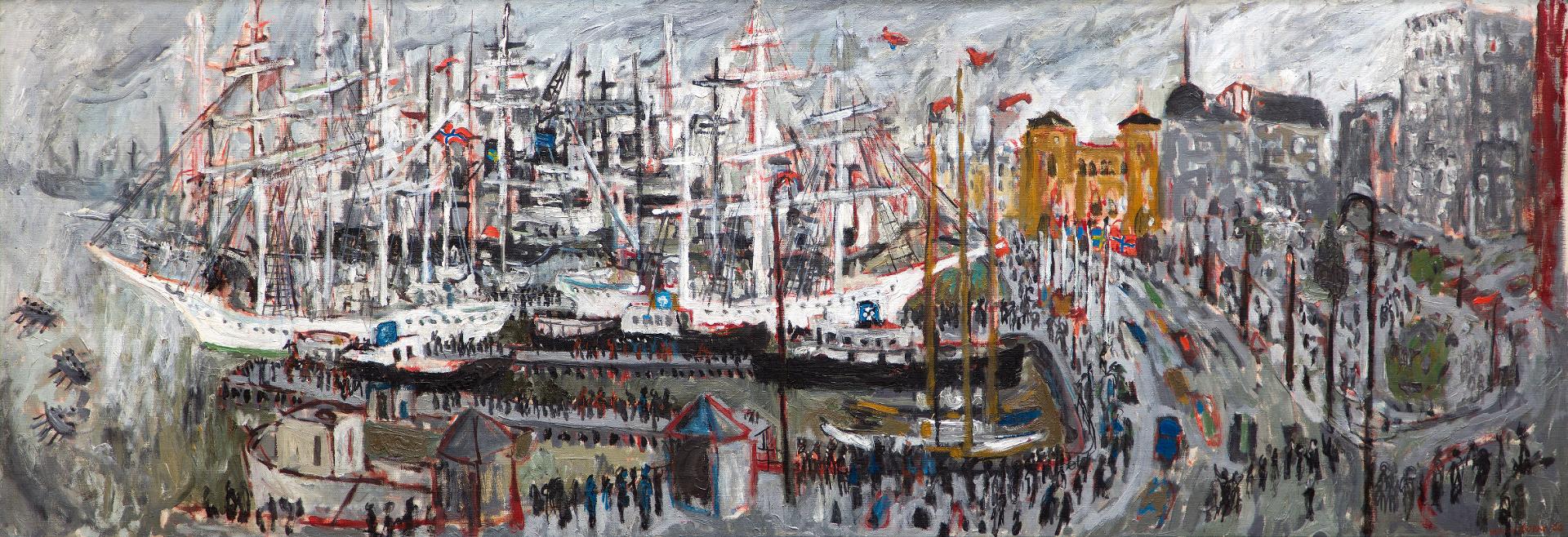
Training Ships at Oslo Harbour, 1960
20 cms x 58 cms (7.87 ins x 22.83 ins)
Signée et datée au bas à droite / signed and dated lower right
Lot offered for sale by BYDealers, Montréal at the auction event "BYDealers - Historical and Post-War Canadian Art" held on Sun, Nov 22, 2020.
Lot 8
Lot 8
Estimate: CAD $30,000 - $50,000
Realised: CAD $30,000
Realised: CAD $30,000
Lot description - from the online catalogue*
Provenance:
Elliott Louis Gallery, Vancouver
Kastel Gallery, Montréal
Collection particulière / Private collection, Montréal
Notes:
Molly Joan Lamb Bobak voit le jour le 25 février 1922 à Vancouver, en Colombie-Britannique. De 1938 à 1941, elle étudie l’art à la Vancouver School of Art avec Jack Shadbolt et Charles Scott. En 1942, elle entre au Service féminin de l’Armée canadienne et devient, en 1945, la toute première femme peintre de guerre canadienne, des fonctions qui la mèneront à Aldershot, au Royaume-Uni et, plus tard, en Hollande. À propos de cette expérience, elle écrit un article intitulé I Love the Army, dans lequel elle confie que c’est l’humanité qu’elle a tenté de saisir, dans ses œuvres. De retour au pays en 1946, elle épouse Bruno Bobak et, ensemble, ils s’installent à Fredericton, au Nouveau-Brunswick. En 1950 et 1951, grâce à une bourse du gouvernement français, Bobak se rend en France pour peindre. Elle retourne en Europe en 1960 et 1961, cette fois avec le soutien financier du Conseil des arts du Canada. En 1973, Bobak devient membre de l’Académie royale des arts du Canada. Ses oeuvres se retrouvent dans de nombreuses collections partout dans le monde. Également illustratrice et enseignante accomplie, elle a travaillé pour plusieurs organismes artistiques nationaux et provinciaux, y compris l’Office national du film, et a fait partie du comité consultatif du Musée des beaux-arts du Canada.
//
Molly Joan Lamb Bobak was born February 25, 1922, in Vancouver, British Columbia. She attended the Vancouver School of Art from 1938 to 1941, studying under Jack Shadbolt and Charles Scott. Bobak joined the Canadian Women’s Army Corps in 1942 and, in 1945, became the first female Canadian war artist; she painted in this capacity at Aldershot, in Britain, and later in Holland. She wrote an article about her experiences titled “I Love the Army,” and was quoted as saying, “It was the humanity I tried to capture in my paintings.” On her return to Canada in 1946, she married Bruno Bobak, and together they moved to Fredericton, New Brunswick. In 1950-51, Bobak painted in France after receiving a scholarship from the French government, and in 1960-61, she returned to Europe on a Canada Council grant. By 1973, she had become a member of the Royal Canadian Academy of Arts. Bobak’s paintings are in many collections around the world, but she was also an accomplished illustrator and teacher. She worked for various federal and provincial arts organizations, including the National Film Board of Canada, and served on the National Gallery’s Ottawa Advisory Board.
Elliott Louis Gallery, Vancouver
Kastel Gallery, Montréal
Collection particulière / Private collection, Montréal
Notes:
Molly Joan Lamb Bobak voit le jour le 25 février 1922 à Vancouver, en Colombie-Britannique. De 1938 à 1941, elle étudie l’art à la Vancouver School of Art avec Jack Shadbolt et Charles Scott. En 1942, elle entre au Service féminin de l’Armée canadienne et devient, en 1945, la toute première femme peintre de guerre canadienne, des fonctions qui la mèneront à Aldershot, au Royaume-Uni et, plus tard, en Hollande. À propos de cette expérience, elle écrit un article intitulé I Love the Army, dans lequel elle confie que c’est l’humanité qu’elle a tenté de saisir, dans ses œuvres. De retour au pays en 1946, elle épouse Bruno Bobak et, ensemble, ils s’installent à Fredericton, au Nouveau-Brunswick. En 1950 et 1951, grâce à une bourse du gouvernement français, Bobak se rend en France pour peindre. Elle retourne en Europe en 1960 et 1961, cette fois avec le soutien financier du Conseil des arts du Canada. En 1973, Bobak devient membre de l’Académie royale des arts du Canada. Ses oeuvres se retrouvent dans de nombreuses collections partout dans le monde. Également illustratrice et enseignante accomplie, elle a travaillé pour plusieurs organismes artistiques nationaux et provinciaux, y compris l’Office national du film, et a fait partie du comité consultatif du Musée des beaux-arts du Canada.
//
Molly Joan Lamb Bobak was born February 25, 1922, in Vancouver, British Columbia. She attended the Vancouver School of Art from 1938 to 1941, studying under Jack Shadbolt and Charles Scott. Bobak joined the Canadian Women’s Army Corps in 1942 and, in 1945, became the first female Canadian war artist; she painted in this capacity at Aldershot, in Britain, and later in Holland. She wrote an article about her experiences titled “I Love the Army,” and was quoted as saying, “It was the humanity I tried to capture in my paintings.” On her return to Canada in 1946, she married Bruno Bobak, and together they moved to Fredericton, New Brunswick. In 1950-51, Bobak painted in France after receiving a scholarship from the French government, and in 1960-61, she returned to Europe on a Canada Council grant. By 1973, she had become a member of the Royal Canadian Academy of Arts. Bobak’s paintings are in many collections around the world, but she was also an accomplished illustrator and teacher. She worked for various federal and provincial arts organizations, including the National Film Board of Canada, and served on the National Gallery’s Ottawa Advisory Board.
Most realised prices include the Buyer's Premium of 18-25%, but not the HST/GST Tax.
(*) Text and/or Image might be subject matter of Copyright. Check with BYDealers auction house for permission to use.
(*) Text and/or Image might be subject matter of Copyright. Check with BYDealers auction house for permission to use.